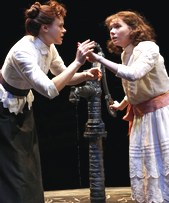SITE GUIDE
SEARCH
REVIEWS
REVIEW ARCHIVES
ADVERTISING AT CURTAINUP
FEATURES
NEWS
Etcetera and
Short Term Listings
LISTINGS
Broadway
Off-Broadway
NYC Restaurants
BOOKS and CDs
OTHER PLACES
Berkshires
London
California
New Jersey
DC
Connecticut
Philadelphia
Elsewhere
QUOTES
TKTS
PLAYWRIGHTS' ALBUMS
LETTERS TO EDITOR
FILM
LINKS
MISCELLANEOUS
Free Updates
Masthead
A CurtainUp Review
The Miracle Worker
By Elyse Sommer
|
Mrs. Keller, I don't think Helen's worst handicap is deafness or blindness. I think it's your love. And pity.— Annie
|

Alison Pill and Abigail Breslin in the famous "Wah-Wah" scene
(Photo: Joan Marcus) |
Whether on Broadway or in small theaters, whether outstandingly acted and staged or falling far short of its teleplay and Broadway beginnings (Playhouse 90 in1957; Playhouse Theater,1959) Helen Keller's story is always worth revisiting. It is one of the most potent ever reminders of the potential to not just survive, but live a fully realized life in the face of extreme adversity.
The Circle In the Square revival is smartly timed to coincide with the play's 50th Anniversary. To extend the fortuitous timing, the March 3rd official opening date is a reminder that March 3, 1887 was the day when Annie Sullivan arrived at the Keller home to begin her determined effort to open the door of the prison of silence and darkness in which young Helen was trapped. To add a dash of something new and NOW, there's the in-the-round staging, the casting of 14-year-old Abigail Breslin whose film credits include Little Miss Sunshine and Alison Pill, a highly regarded young stage actress (Mauritious, Reasons to be Pretty, Blackbird) as Helen and Annie, and direction by Kate Whoriskey who helmed last year's Pulitzer Prize winning Ruined.
My own hopes for this production were buoyed by my geographic connection to the play: The Forest Hills apartment house I live in is just a block away from where Helen Keller and Annie Sullivan lived for years which is understandably a point of great pride to residents and neighborhood historians. My Berkshire home is just one town away from where William Gibson lived and the library where he first discovered a book of Annie Sullivan's letters detailing how she headed from her training at the Perkins Institute in Boston to bring language to a young deaf and blind child named Helen Keller. It was also in the Berkshires where Gibson's Golda's Balcony, a one-person version of his multi-character play about Golda Meir was successfully nurtured and showcased by Shakespeare & Company. And it was in another Berkshire Theater (Berkshire Theater Festival), when Gibson was still alive and in the audience, that I last saw a production of The Miracle Worker. Like other regional revivals it was done without complicated scenery changes.
Unlike that last seen regional theater production, the new revival has all the earmarks of a big Broadway show. And much as I admire Derek McLane's work, his elegant scenic design somehow puts too much of the focus on the wrong miracle. McLane's miraculously rising and falling scenery tends to upstage and diminish the emotional power of Annie's miracle. It's not that McLane hasn't supplied everything needed for the various locations: a very handsome dining room table for the first wrenching battle to tame Helen's tantrums, a battle that leaves the Keller dining room a wreck but Helen's napkin folded . . . the pump where we rejoice at the halting "wah-wah" that signals Annie's cracking the code to the "locked safe" that has been Helen's mind. . .the two hanging doors at either end of the stage serve as an apt metaphor for the door being so painstakingly and persistently opened for Helen.
Granted, this is not an easy venue. Unlike other thrust stages which usually have the audience surround a smaller playing area, the Circle In the Square stage resembles a long fashion show runway with the audience all around. Thus, while the last row of each section is closer than it would be in a conventional proscenium theater, it's quite a challenge to avoid distancing viewers from the actors and having them see an actor's back. This wasn't a problem with last year's The Norman Conquests and, in fact added to the fun. However, in this case, the in-the-round staging isn't especially suited to this serious drama that, true to its genesis on the small screen, calls for lots of up-close interaction.
To Kate Whoriskey credit, she has directed her actors' movements so that the runway stage's sight line problems are, if not avoided, evenly distributed. However, this even-handed approach has its own drawback in that it's not seamless. Like the up and down moving scenery, it makes one too conscious of being in a theater watching actors rather than losing oneself completely in the story. As for the play itself, the new, new thing that might most benefit Gibson's script, which was always rather didactic, might be to streamline the dialogue and let the physical and most dramatic scenes dominate.
What about the cast? The actors, including the ones with minor roles (especially Elizabeth Franz as the Aunt Ev), are clearly committed to their characters. All are beautifully dressed by Paul Tazwell in keeping with the period and their characters. However, no one stands out as extraordinary enough to make anyone's memory book of great performances.
At thirteen, Abigail Breslin, is just a few years older than Patty Duke was when she pioneered the role of Helen, and she's probably the main attraction for audience members close to her age. Breslin has fearlessly given up her adorable persona and with an assist from Lee Sher's physical and movement coaching, has creditably mastered the grunts and groans of the frustrated, over-indulged blind and mute child. It's a respectable stage debut. As for Pill, she is believably scrappy yet tightly strung as the feisty young teacher. Her most touching moments are the hokey but effective flashbacks that recall her own memories of her dead brother and her own experiences. If Breslin and Pill don't erase memories of the original actors, their performances sustain the indestructible drama of these heroic characters.
The Keller family member who most touches the heart strings is Jennifer Morrison as the mother who must learn how to best love her child from another woman. Matthew Modine cuts a dashing figure as Captain Keller who obviously was better able to deal with the men he commanded during the war than with James (Tobias Segal), the son from a first marriage, and the afflicted wild child of his union with the younger Kate. Though rather obvious, the son's having to shout to be heard and understood by his macho father, does serve as a counterpoint to the battle of wills between young Helen and her teacher.
As I said at the outset, The Miracle Worker is a play about a miracle that really happened and that continues to amaze and inspire. The determination of Annie Sullivan, the courage of Helen's mother to listen to her head as well as her heart and let Annie take charge of her child, and the extraordinary achievements of the girl released from her dark and silent world . . . we need miracles like that to inspire us to find ways to unlock the doors that can lead us out of the dark shadows overhanging our world to a brighter and more optimisitic one.
Postscript: Some facts about The Miracle Worker
The 1959 Broadway production played 719 performances, before its July 1,1961 closing. It earned three Tony Awards: Best actress for Anne Bancroft, best director for Arthur Penn and for Best Play. Bancroft and Patty Duke reprised their roles as Annie sullivan and Helen Keller for Gibson's 1962 screen adaptation, again directed by Penn. Duke also starred in a 1979 television version in which she became the teacher to Melissa Gilbert's Helen Keller.
|
The Miracle Worker by William Gibson Directed by Kate Whoriskey Cast: Cast: Abigail Breslin (Helen Keller, Alison Pill (Annie Sullivan), Elizabeth Franz (Aunt Ev), Matthew Modine (Captain Keller), Jennifer Morrison (Kate Keller), Tobias Segal, (James) Daniel Orsekes (Doctor Anagnos), Michael Cummings (Percy), Simone Joy Jones (Martha), Yvette Ganier (Viney), Lance Chantiles-Wertz (Jimmie) Sets: Derek McLane Costumes:Paul Tazewell Lighting: Kenneth Posner Original Music and sound: Rob Milburn and Michael Bodeen Hair Design: Charles La Pointe Physical Coaching & Movement: Lee Sher Stage Manager: J. Philip Bassett From 2/12/10; opening 3/03/10 Tuesday, Wednesday and Thursday at 7pm, Friday and Saturday at 8p, Wednesday and Saturday matinees at 2pm. Sunday matinees at 3pm. Dark Monday. Running Time: 2 hours with intermission (Act 1 60 minutes; Act 2: 40 Minutes) Circle in the Square Theatre 235 West 50 Street Tickets: $117 Reviewed by Elyse Sommer February 27th press matinee To an early grave: Closing 4/28/10 |
|
REVIEW FEEDBACK Highlight one of the responses below and click "copy" or"CTRL+C"
Paste the highlighted text into the subject line (CTRL+ V): Feel free to add detailed comments in the body of the email. . .also the names and emails of any friends to whom you'd like us to forward a copy of this review. You can also contact us at Curtainup at Facebook , Curtainup at Twitter and at our Blog Annex |
|
Subscribe to our FREE email updates with a note from editor Elyse Sommer about additions to the website -- with main page hot links to the latest features posted at our numerous locations. To subscribe,
E-mail: esommer@curtainup.comesommer@curtainup.com
put SUBSCRIBE CURTAINUP EMAIL UPDATE in the subject line and your full name and email address in the body of the message -- if you can spare a minute, tell us how you came to CurtainUp and from what part of the country. |





